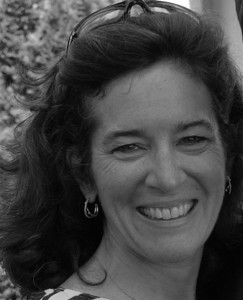 Nan left a demanding job running an international firm in order to write a book, and in the process found a passion for the bike.
Nan left a demanding job running an international firm in order to write a book, and in the process found a passion for the bike.
When did you start to think about charting a new direction for yourself in midlife?
Every 10 years or so, I reassess what I’m doing, whether intentionally or not, and consider if I want to remain on the course I am on or whether there is something else I’d rather do.
Of course I’m anxious before I make any change in my life: What if it is the wrong decision? What if I fail and I can’t go back to where I was before? But it’s always more frightening for me to stay on my current course and miss possibly learning about who I really am.
In 2008, at age 46, I left my role as President of The International Forum to write a book and spend more time with my family. This decision ended up being one of the most dramatic and meaningful ones I have ever made. It was very difficult to leave my job, which had defined who I was until that point, and step onto a path where I had virtually no experience. But it has opened more doors than I could have expected.
What is your next act? Tell us about what you are doing…
Ironically the book I left my work to write is about 7 people who each took a step off the path and discovered what they were probably supposed to do in their lives.
I walked away from a good business career and became a writer and a cyclist. Both have taken an incredible amount of work and heartache. Both involve daily commitment to becoming better. Both involve patience and persistence before ever seeing results. But, for the purposes of this interview, I will focus on the cycling part.

At the age of 51, even I am surprised by what has transpired. My cycling coach jokes and calls me a “freak of nature.” But the truth is, and he knows it, that it all comes down to hard work and hours on the bike: For the past few years, I have been training 9-15 hours a week.
Most competitive cyclists are in their mid 20’s to early 30’s, after which most retire to have families. In fact I’d say 95%+ of the racers fall into this age bracket. At a race I completed this fall, the woman who beat me was 56! There aren’t many of us older ladies out there – so that was really unusual. But I didn’t feel so bad that I lost to her when I found out her age. It was inspiring and reassured me that I still have time.
Why did you choose this next act? How hard was it to take the plunge? How did you prepare?
The funny thing about this next act is that I don’t ever remember choosing it. I certainly never planned for it. Not in a million years would I have expected to have the experiences I have had nor accomplished what I have. I just kept saying yes to opportunities, even when they scared me. Something in me said if I didn’t try it, I would regret it.
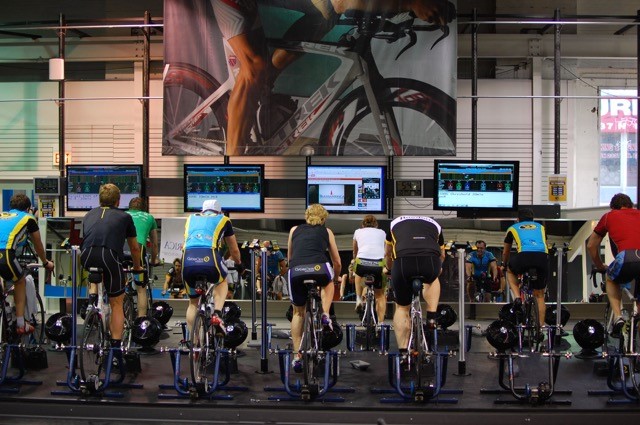 Taking the initial plunge was not hard at all. It all started because I had more time on my hands and I needed to get in shape and lose some weight. So I went to a local studio where you put your bike on an indoor trainer and ride for an hour or so a few days a week (like spinning class with your own bike). As we got close to spring, another rider asked if I would be interested in doing a 100-mile ride for charity. I told her there was no way I could ride that far.
Taking the initial plunge was not hard at all. It all started because I had more time on my hands and I needed to get in shape and lose some weight. So I went to a local studio where you put your bike on an indoor trainer and ride for an hour or so a few days a week (like spinning class with your own bike). As we got close to spring, another rider asked if I would be interested in doing a 100-mile ride for charity. I told her there was no way I could ride that far.
I just kept saying yes to opportunities, even when they scared me.
After some convincing on her part, I agreed to give it a try and then the guy who ran the bike studio gave me a training plan to get me ready. First thing I had to do was to get a proper bike (a road bike). The next thing was to get used to riding my bike 4-5 days a week. Starting at 25 miles, I eventually built up to 60-70 miles. I didn’t do very well on the first 100-mile ride, but I was hooked anyway. That summer, I went on to do two more charity rides. By the fall, I was ready to try more.
I decided that fall to set another goal for myself: 206 miles in one day. I had heard about a ride/race that started in Utah and ended in Wyoming, called The Lotoja Classic. I remember thinking that I would never be able to do it, but something in me wanted to try.
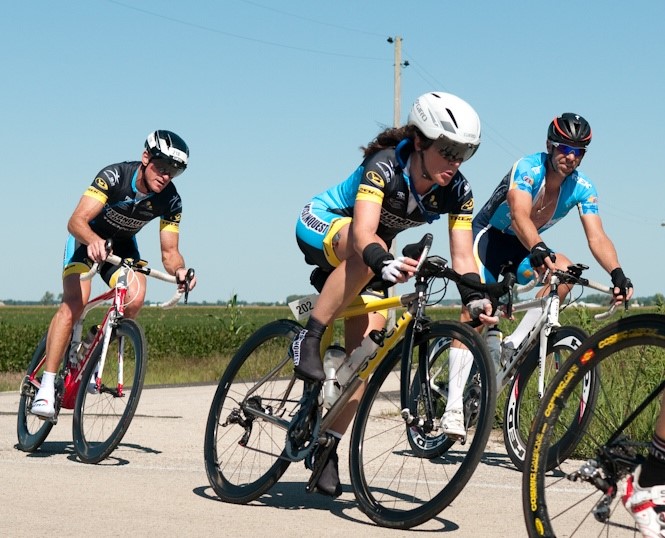 One of the things I had learned by tackling 100-mile charity rides is that the secret to finishing well is to take it one step at a time so as not to be overwhelmed by the task as a whole. In other words, train diligently and intelligently, then, when the actual event happens, break down the task into chunks. It’s much easier to accomplish 20 miles at a time than to think about all 100 miles at once.
One of the things I had learned by tackling 100-mile charity rides is that the secret to finishing well is to take it one step at a time so as not to be overwhelmed by the task as a whole. In other words, train diligently and intelligently, then, when the actual event happens, break down the task into chunks. It’s much easier to accomplish 20 miles at a time than to think about all 100 miles at once.
What challenges did you encounter?
I trained for a year for The Lotoja Classic and, in the process, I discovered racing. My coach at the time thought I had the legs for it and that I might actually do well. So I tried Time Trials, solo races against the clock in a very aerodynamic position. I did well and took home second and third places in my first two races.
I then went on to try Criteriums, very short intense group races. I placed first and third in two of those. After that, I jumped way beyond my ability and did a national stage race (3 days of races) in the mountains. I still had work to do there, but I did place in the top half overall.
Everything was going well that year up until 3 weeks before The Lotoja Classic, my big event. I was fit; I was ready. Then, on a simple training ride, I swerved to avoid another rider who went down and I lost control of my bike, landed on my head (helmet on), and was knocked unconscious. I was rushed to the hospital, suffered head trauma, bleeding in the brain, concussion, etc.
Despite not being able to finish sentences and suffering from headaches, I checked out pretty well with the neurologist. When I asked him whether I could get back on the bike, he said yes, but I could only ride part of the Lotoja Classic, not the full 206 miles.
So I went with the sole intention of learning about the course, testing my fueling plan, and getting the lay of the land by only riding 125 of the 206 then stopping. I planned to return the next year and finish the job.
It was the right decision from a race preparation perspective. The Lotoja Classic is the longest bike race in America and requires a thoughtful strategy in addition to superior fitness. When I returned to race the full course in 2012, I discovered that my preparation had paid off: I placed 9th in my category against 35 women, with a time of 10:36 hours, beating my own goal by an hour. Here’s an article I wrote about the experience.
Train diligently and intelligently, then, when the actual event happens, break down the task into chunks.
But competing in this race for any duration right after my accident was the wrong decision from a health perspective. When I got home in 2011 after my partial attempt, I was in a very bad state. I lost a good chunk of my memory and speech, and riding the bike made me dizzy and nauseous. It must have been a delayed reaction to the trauma of my accident. So I had to stop riding completely.
What followed was about 6 months of recovery, the likes of which I have never experienced before. Physically, I was back by the following spring, as strong as before, but I did not regain my confidence for a while and my memory remained unpredictable until 14 months after the crash.

This past January, I won first place women overall in the 107-mile Gran Fondo Brevard on the east coast of Florida. The term Gran Fondo translated means “big endurance;” these kinds of events are usually 100+ miles long. They were originally created in Italy in the early 1900’s but have recently become very popular in the U.S. Gran Fondos can be a full-on race or just a really long, timed ride.
This race was particularly exciting for me as I was competing against women to whom I’d lost before. Last year, I placed 4th in in this same race. My goal this year was to ride hard and smart and come up with a plan to win. It wasn’t until I was 5 miles from the finish line that I figured out what I was going to, and it worked. As any racer will tell you, a lot of times it doesn’t. Which is why, I think, the victory feels so sweet when it finally happens.
Were there times when you thought about giving up?
There are never times when I think about giving up the bike. But there are many times when I want to give up on a workout or on a race… Sometimes it just gets so hard and you feel like there’s no way you can dig yourself out of the pain. When that happens, I tell myself that if I can just finish, that is the accomplishment. Sometimes it takes everything I have (or didn’t even know I had) to finish. I’ve cried a lot and screamed and cursed. (My new coach doesn’t let me cry. He’d prefer I curse instead.)
I remember in particular my first gravel race last spring. It was late March in Michigan. Seventy percent of the course was on dirt roads; it had rained and frozen, snowed and thawed, so the roads were slick mud. It was a hilly, 65-mile course and bitter cold.
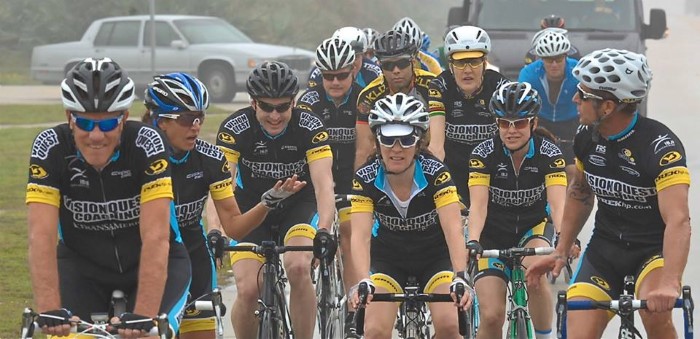
I was fine the first 15 miles and held on to the leaders. But, at some point, after all the slipping and skidding, I lost my energy. I guess I hadn’t eaten enough. In biking terms I “blew up,” “hit the wall,” ”bonked.” I got dropped by the fast group at about 25 miles. At the 45-mile aid station, I stopped and asked one of the support crew if I could get a ride to the finish line. I was going to quit. I was in such agony, freezing cold, alone, with no chance of placing in the top 10.
Sometimes it takes everything I have (or didn’t even know I had) to finish. I’ve cried a lot and screamed and cursed.
Then, I changed my mind. I knew if I didn’t finish, I wouldn’t be able to live with myself. So I got back on the bike and toughed it out. The wind was blowing and it started to sleet. I came in 14th place, the worst I have ever done; but I didn’t give up.
I suppose you might ask: Why do I bother? Why put myself through it? After all, I’m too old to race as a professional and there is no chance of making it to the Olympics at my age. The answer is that for the first time in my life, I am on a path that just feels right. I don’t have to work hard to be someone I’m not, someone others expect me to be; I just have to work hard to be the best me there is.
That is not as easy as it sounds, but it’s much more fun working hard at something you feel you are meant to do than working hard at something in which you find no meaning. I expect that this path will lead me somewhere else too, though it is not entirely clear yet where that is. I am okay with that.
For the first time in my life, I am on a path that just feels right. I don’t have to work hard to be someone I’m not, someone others expect me to be; I just have to work hard to be the best me there is.
I have noticed recently that as I overcome and accomplish things, people are watching and asking for my help. They tell me my struggle has inspired them to try things they might not have otherwise. That means something.
What or who keeps you going? What’s been the reaction from family and friends?
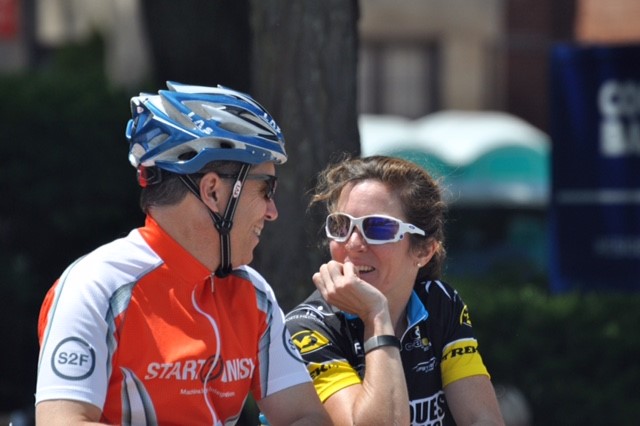
Nan and Brian
My husband, Brian, is my best support. He doesn’t insert himself into my training day to day, but every once in a while he puts his foot down and says it is too slippery, icy, or dangerous outside and he does not want me to train on the road. The last time he did this the group I was supposed to ride with hit a patch of ice and everyone crashed (two were rushed to the hospital and are now in rehab for shoulders and knees). So I listen to him.
The biggest worry my immediate family has is the possibility of crashes. Because of that, I don’t race high-risk races anymore; I don’t want to push things and take risks that might affect them. I also have to walk a fine line between family time and training/competing time. I train 15 hours a week in season and 8-10 hours a week off season. Most competitions are on weekends, so I pick and choose my events. I approach cycling like the rest of life: There are tradeoffs. At least I’m happy with mine. No one in the family will bike with me now though!
Initially people thought I was nuts. Mainly my friends couldn’t understand why I was doing this. It was such a departure from the cerebral world of international business. But after a few years and some good results under my belt, they have slowly come around to accepting it. For the most part, people don’t ask me about it: It’s such a different world from the one in which we live.
My parents think it’s great. Every once in a while, my mother worries about my riding on the road alone and cars. My father is having fun reliving his early years as a track star.
What words of advice do you have for women seeking to reinvent themselves in midlife?
Cycling has taught me more about facing fear and overcoming lack of confidence than anything else I’ve done in life. I think in part because it is so simple: You work hard, you work smart, and eventually it pays off. It’s very empowering.
Life isn’t always like that. Sometimes we work hard, we work smart and someone else gets the opportunity. But in cycling I have learned what it feels like to have all that is superficial about you stripped away so that all that’s left is just who you really are. It doesn’t matter where you went to school, how much money you have, how good you look, etc.
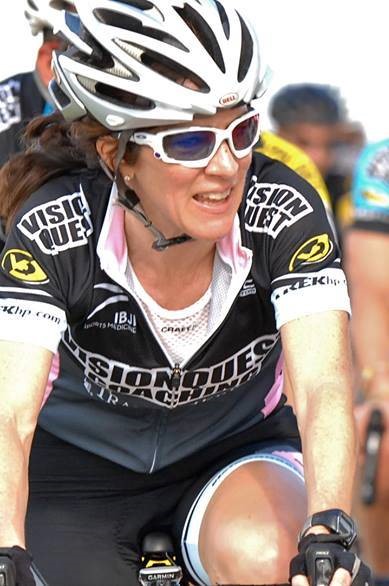
As I’ve come face to face with things that scare me, I have learned to understand what’s scary about them and work through it. I have put my body and mind in situations I would never have dreamed of and survived.
Take one step at a time. Don’t worry about the end game, don’t even worry about where your next act is leading you.
I think it has helped a lot that there have been no expectations for me to do well in this sport – after all, I am old enough to be everyone’s mother out there. So I am at peace with failing and trying again…and again.
It’s a liberating feeling that I hope more women have the chance to experience, whether on the bike or doing whatever it is they are afraid to try but secretly want to do.
More practically, my advice now to women who want to try their Next Act is to take one step at a time. Don’t worry about the end game, don’t even worry about where your next act is leading you; just trust in your decision, go with it and give it your all. If it feels easy or right, then that’s a really good sign.
Whatever you choose to do next, don’t face it alone.
And finally, whatever you choose to do next, don’t face it alone. If you do, chances are you won’t make it, or at the very least it won’t be nearly as much fun. I think if what you choose involves real effort and is worth doing, at some point you will stumble, fall, or maybe even consider quitting. Having people around you who believe in what you are trying to do and who can mentor you through the tough spots it is really important. I know that without others I would have never accomplished what I have in cycling so far; I just didn’t believe enough in myself.
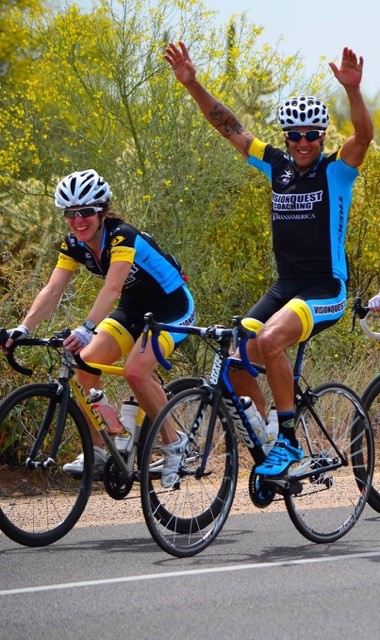
Nan with Carlos, her coach
My coach, Carlos, has been my mentor and teacher. He believes more in me than I do at times. Robbie Ventura, who is the founder of Vision Quest Coaching and a former professional cyclist, has dared me to reach for goals I never thought I could achieve. The more seasoned women I have trained and raced with have really encouraged me and passed on much of what they have learned. There have been many days where I was afraid or doubted myself but, thankfully, I have never been alone at this.
What words of advice do you have for those interested in pursuing your path?
I am a mentor now to other women starting out on the bike. My advice is to get out there and ride. Find a supportive group of other riders and set a goal for yourself. The goal can be, like mine, to ride 100 miles for a charity or it can be something else.
In sports, it helps to have that goal, because a big part of getting there is scheduling your training time. But I don’t think you need a long-term goal at the outset. In fact, it’s better not to have one. Wait and see where the road takes you; you may be surprised. The long-term goals will reveal themselves as the short-term goals are achieved.
Start with local time trials. Even though you race alone in these, they are a good place to practice preparing for a race, warming up, and thinking about your strategy. Next I would try some criteriums –which are short, fast races around a short course several times. You could also jump right to long races (25-60miles) or try a stage race (3 days of racing) as I did. You can also try gravel bike racing, which is on a cross bike that has fatter tires than road bikes, not as fat as a mountain bike. They are more laid back than road races, but still give you a flavor of racing. Definitely get some advice and coaching before you try any of these. There is a strategy to racing and things to be mindful of as you prepare and while you race.
Wait and see where the road takes you; you may be surprised.
Keep in mind you can’t earn much winning or placing in competitive cycling, especially if you’re a woman! Check out the movie Half the Road. I have won a couple of hundred dollars for my modest placements. Some of the purses are over $1,000. In terms of sponsors, there is not a lot of money in women’s cycling. But the more you bike and the better you do, you get a lot of “swag” – clothing, bags, bottles, food, minor equipment etc. No one has yet offered to outfit me with a new bike, but it happens.
Through the cycling community, I am now connected with and support World Bicycle Relief, an organization that provides bikes to women, men, and children in remote and impoverished communities around the world to improve their access to education, healthcare, and markets. I can attest firsthand to the power of bikes and the unexpected places they take us.
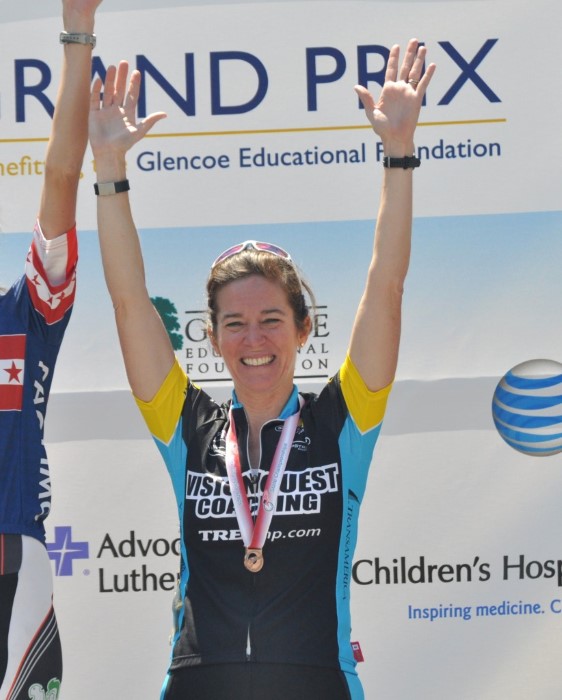
What resources do you recommend?
Inventing the Rest of Our Lives: Women in second adulthood by Suzanne Braun Levine.
Smile at Fear by Chogyam Trungpa.
Base Building for Cyclists by Thomas Chapple
The Cyclists Training Bible by Joel Friel
Serious Cycling by Edmund R. Burke
Training and Racing with a Power Meter by Hunter Allen and Andrew Coggan
Weight Training for Cyclists by Ken Doyle and Eric Schmitz
Racing Weight by Matt Fitzgerald
Chicago Bike Racing
If you live in the Chicago area:
Vision Quest Coaching: Contact Dave Noda at dave@visionquestcoaching.com
Pedaling with a Purpose: Contact Kristen Meshberg at kmeshberg@comcast.net
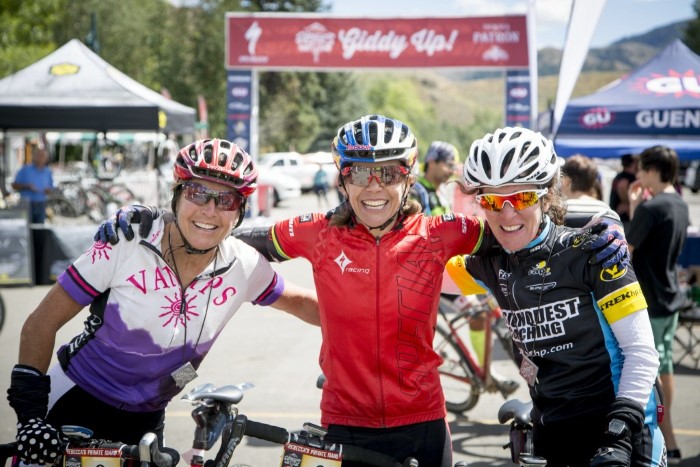
Nan (right) with Rebecca Rusch (center, #1 female mountain bike racer in the world) and Muffy Ritz (well-known cross country ski champion)
What’s next for you? Do you think you have another next act in your future?
The outlook for 2015 is even more exciting as I feel I am finally coming into my own in partnership with a great coach, Carlos Soler from Vision Quest Coaching. At the same time, I am feeling my age and things hurt more than they used to. So we will see what happens next.
I also hope to get a publishing deal for my book this year. And then, of course, check back with me in 2018, when I do my next 10-year re-evaluation of my personal goals and aspirations.
Contact Nan Doyal at www.cyclistjournal.wordpress.com or follow her on twitter @nandoyal
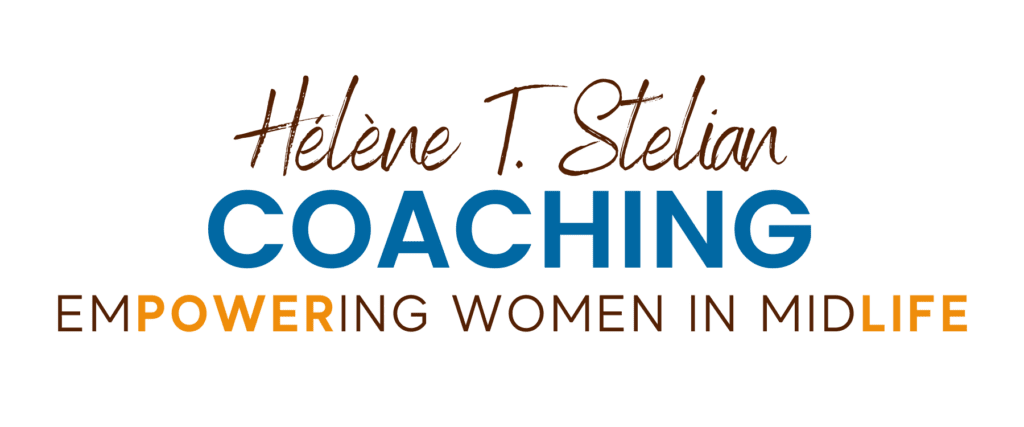
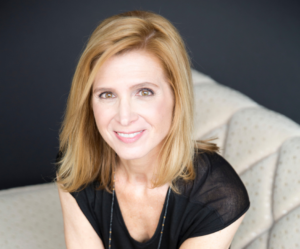
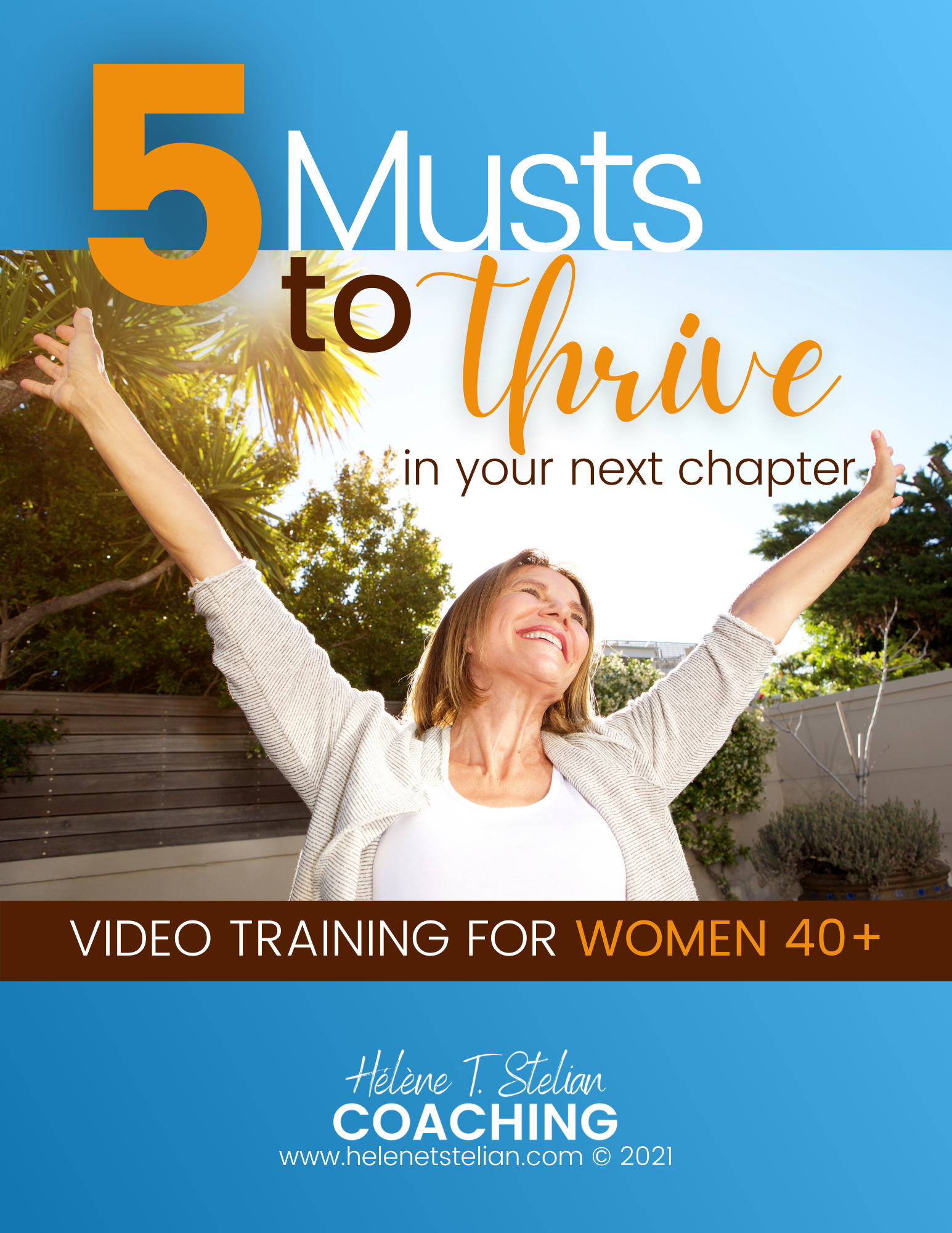


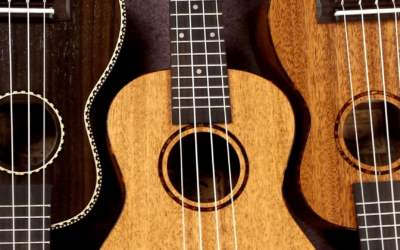
I absolutely agree with breaking down longer bike rides (100m plus) into their component parts; beginning, middle and end. I used to lose energy after 60/70 miles but now know how to eat and drink appropriately to finish strong-ish.
Great article and thanks for your sharing.
Awesome and inspiring story about how commitment and grit can take us to the next level. Thanks for the reminder to find other riders with similar goals!
Hey Helena thanks for the inspirational post. I am 42 and started cycling.Your post will help me a lot.
Hello Helena
Thanks for the informative and also inspirational post for all bike rider.basically I want to say that when we are beginner with bike riding so definitely attend a course and the go through..